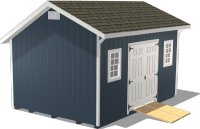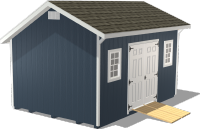Get Ready to Grow: Essential Backyard Greenhouse Ideas for Beginners
by Dakota Storage Buildings, on July 05, 2024

Starting a greenhouse garden is an exciting next step for many gardeners. However, even experienced gardeners can face challenges such as choosing the right location, determining the best structure for their needs, and understanding the nuances of climate control within the greenhouse. Our goal is to provide accessible and practical backyard greenhouse ideas, offering clear, step-by-step guidance tailored to help seasoned gardeners confidently build and manage a thriving greenhouse. By breaking down each element — from selecting materials to planting and daily maintenance — we help simplify what can initially seem overwhelming.
Essential Backyard Greenhouse Ideas for Beginners
Starting a greenhouse can transform your gardening experience by allowing you to extend the growing seasons and cultivate a more diverse array of plants. Whether gardening is a hobby or you are looking to maximize crop yields, understanding the fundamentals of greenhouse management is critical for success.
Choosing the Right Location
The success of your greenhouse largely depends on its placement, which can significantly impact everything from the health of your plants to the longevity and efficacy of the structure itself.
Sunlight Exposure: It is vital to ensure the greenhouse receives adequate sunlight, which is essential for the photosynthesis process in plants. Ideally, a greenhouse should have at least six hours of direct sunlight per day, but more could be beneficial depending on the types of plants you plan to cultivate. More sunlight not only promotes better growth but also naturally heats the greenhouse, which can be particularly beneficial during the cooler months, reducing the need for artificial heating.
Wind Protection: Selecting a location that is shielded from strong winds is crucial. Wind can potentially damage the structure or significantly reduce heat retention during colder months. A spot near a natural windbreak such as dense trees or a constructed barrier like a fence or wall can provide the necessary protection. Effective wind shielding not only prevents physical damage to the greenhouse but also helps maintain a more stable internal temperature.
Proximity to Water Source: Having a water source nearby greatly simplifies the watering and maintenance tasks, making regular care more convenient and less time-consuming. Consider the logistics of running water lines to your greenhouse if it is not near a natural supply. Proper hydration is crucial to plant health, and having easy access to water not only ensures that plants can be regularly and efficiently watered but also encourages consistent care and maintenance. This can be especially important during peak growing seasons when plants may require more water to thrive.
Exploring Greenhouse Types for New Gardeners
Choosing the right type of greenhouse is essential for your gardening success. Each design caters to different needs and spatial constraints, ensuring that every gardener can find a fit that complements their capabilities and goals.

Source: GardenersWorld
Small Lean-To Greenhouses: Ideal for small gardens or limited spaces, these greenhouses attach directly to a wall or fence, which significantly saves on space while still providing sufficient growing conditions. Their compact design allows it to easily integrate into your home's landscape, often without the need for additional structures or complex modifications. They offer the convenience of utility access and are particularly beneficial for beginners. This type of greenhouse is perfect for growing a modest amount of plants or for those who may just be getting started with gardening and want to manage a manageable number of plants.
Traditional Greenhouses

Traditional Greenhouses: These freestanding structures are highly versatile, offering significant flexibility in terms of size and design. They are the go-to choice for gardeners who are looking to increase their number of plants. The ability to customize traditional greenhouses with various features such as automatic ventilation and heating systems makes them adaptable to many different climatic conditions. They are able to be placed in optimal locations for sun and shade, which is critical for controlling the internal climate. These greenhouses are suitable for a wide variety of uses, from starting seedlings and growing vegetables to cultivating exotic flowers and plants that require controlled conditions. The customization options also mean that you can design a greenhouse that not only meets your current gardening needs but can also evolve with your planting goals. They provide ample room to introduce benches, shelving, and even automated systems for watering and climate control.
Discover more types of greenhouses and find the perfect fit for your plants.
Creating the Perfect Environment for Plant Growth
Setting up your greenhouse correctly is pivotal in creating an optimal environment that promotes robust plant growth and health. Here are some backyard greenhouse ideas to ensure your plants have the best conditions to thrive.
Installing Effective Ventilation and Heating
Proper ventilation and heating are essential for maintaining an appropriate climate within your greenhouse. Installing systems that provide adequate airflow helps prevent the buildup of heat and humidity, which are common causes of plant diseases. Good ventilation systems also ensure a constant supply of fresh air, enhancing photosynthesis and plant resilience. Heating systems, on the other hand, are crucial during the colder months. They help maintain a consistent temperature that is crucial for preventing frost damage and ensuring year-round growth.
Efficient Irrigation and Watering Systems
Water is crucial and setting up an efficient irrigation system can significantly impact your plants’ health and yield. Automated drip irrigation systems are particularly effective as they deliver water directly to the plant roots at consistent intervals, ensuring optimal soil moisture without any waste. This method not only conserves water but also prevents the surface wetting of leaves, which can lead to fungal infections. Consider incorporating moisture sensors that can help tailor watering schedules based on real-time soil conditions.
Durable Foundation and Framework
The durability of your greenhouse depends significantly on its foundation and structural integrity. A strong, stable foundation ensures that your greenhouse remains secure and upright in adverse weather conditions, protecting your plants and investment. It is important to choose materials that are resistant to rot, pests, and corrosion. The structure of your greenhouse should support the weight of your plants, equipment, and any snow or debris that may accumulate on the roof. Regular inspections and maintenance of the foundation and structure can prevent minor issues from becoming major problems, ensuring the longevity of your greenhouse.
Learn everything you need to know about laying a durable greenhouse foundation.
How to Pick the Right Plants for Your Greenhouse
Selecting the right plants is crucial for making the most out of your greenhouse. It is essential to choose species that are well-suited to the specific climate and conditions of your enclosed space.

Selecting Plants for Seasonal Success
The success of your greenhouse largely hinges on picking plants that are compatible with the internal conditions you can provide. This includes considering the temperature range and humidity levels typical of your greenhouse across different seasons. For instance, if you live in a cooler climate, opt for cold-hardy plants or install an adequate heating system to grow more tropical varieties. During warmer months, plants that thrive in heat and humidity can be more successful.
Planting and Care Techniques
Proper planting techniques are fundamental to the health and productivity of your greenhouse plants. Start by understanding the best practices for seeding or transplanting. Some plants might need to be started in small containers or germination trays before being moved to larger pots or directly into the ground. Knowing when and how to prune, fertilize, and manage pests organically can greatly influence your plants’ health. Regularly inspecting plants for signs of stress, pests, or disease is critical for maintaining a healthy greenhouse environment. Implement a feeding schedule that meets the nutritional needs of each plant type, and adjust your watering practices based on the moisture requirements of each species to prevent over or under-watering.
Key Strategies for a Thriving Greenhouse Gardening
Greenhouse gardening requires a strategic approach to create an optimal environment for plant growth. Here are some crucial strategies to ensure your greenhouse remains a productive and healthy space for your plants.
Optimizing Temperature
Proper temperature control is essential in a greenhouse setting to simulate the ideal growing conditions for various plant species. Utilize thermostats and environmental sensors to monitor and adjust the temperature as needed. During colder months, heating systems can maintain a warm environment, while in warmer climates, ventilation and evaporative cooling systems can help manage excessive heat. This proactive approach to temperature management reduces stress on plants, promoting healthier growth and productivity.
Natural Pest Control
Maintaining a pest-free greenhouse is key to protecting your plants. Implement integrated pest management (IPM) strategies that focus on natural and organic methods. Start by introducing beneficial insects that prey on harmful pests. Utilize barriers or screens to prevent pests from entering, and apply natural remedies like neem oil or insecticidal soap to manage infestations. Regular inspections are crucial; carefully check your plants for signs of pests and diseases and respond promptly to any issues. By avoiding synthetic chemicals, you maintain a safer environment for both your plants and yourself, ensuring that your greenhouse remains a sustainable ecosystem.
Space-Saving Techniques to Maximize Growth
Making the most of your available space is crucial in a greenhouse setting, where every inch counts towards increasing your planting potential. Here are some effective methods to efficiently utilize the space in your greenhouse.
Vertical Gardening Solutions

This technique allows you to maximize the vertical space within your greenhouse, offering a new dimension of growing potential. Install vertical planters or use trellises and climbing structures to support vining vegetables and flowers, such as tomatoes, peas, beans, and even some varieties of squash. Vertical gardening not only saves space but can also help improve air circulation around plants, reducing the risk of fungal diseases.
Shelves and Hanging Baskets

Adding shelving units provides extra surfaces for smaller pots or seed trays, expanding your growing area without needing more floor space. Consider adjustable shelves to accommodate plants of different heights and stages of growth. Hanging baskets are perfect for ornamentals like petunias or for growing herbs and strawberries, which benefit from the enhanced airflow and extra sunlight exposure that elevated growing offers.
Explore more interior greenhouse layouts to maximize space.
Backyard Greenhouse Ideas for Long-Term Success
Ensuring the longevity and optimal function of your greenhouse involves consistent maintenance and attentive care. Here is how you can keep your greenhouse in excellent condition year-round.
Maintain a Healthy Greenhouse Environment
Regular cleaning is essential to prevent the buildup of mold, mildew, and algae, which can thrive in the humid conditions of a greenhouse. Clear out plant debris, wash down surfaces, and ensure that gutters and water outlets are free from blockages to prevent water stagnation. Implementing integrated pest management (IPM) practices helps manage pests organically by encouraging beneficial insects, using traps, and applying natural pesticides only as a last resort. This approach minimizes the reliance on chemical treatments, promoting a healthier environment for both plants and pollinators.
Ensure the Perfect Interior Climate
Monitoring and adjusting environmental conditions are crucial to the success of your greenhouse gardening. Use hygrometers and thermometers to regularly check the temperature and humidity levels, and adjust ventilation or heating as necessary to create the ideal climate for your plants. Many plants have specific climatic needs, and even slight deviations can impact their health and productivity. By keeping a close eye on these conditions, you can prevent stress and disease in your plants and ensure growth.
Expand Your Greenhouse Gardening Skills
As your confidence and experience in greenhouse gardening grow, you can dive into more advanced techniques that can enhance your gardening capabilities and expand your horticultural knowledge.
Plant Propagation and Hybridization
Master the propagation skills to increase your plant collection without additional cost. Start with simple techniques like cuttings, grafting, or layering, which can be fun and rewarding. Hybridization, or cross-breeding plants, can be an exciting way to develop new plant varieties with desirable traits, such as improved flavor, disease resistance, or unique aesthetics. This allows you to customize your plant offerings to suit your tastes and conditions.
Strategies to Maximize Your Yield
To get the most out of your greenhouse space, experiment with advanced planting techniques such as companion planting, which involves placing plants together that benefit each other by deterring pests, enhancing growth, or optimizing nutrient uptake. Implement space-utilization strategies like succession planting and intercropping to ensure continuous production and efficient use of space. Learning to optimize the vertical and horizontal dimensions of your greenhouse can lead to a significant increase in productivity, allowing for a greater variety and volume of produce throughout the year.
Your Path to Successful Greenhouse Gardening

With the right knowledge and tools, anyone can embark on the rewarding journey of starting and maintaining a successful greenhouse. Whether you are a new or seasoned gardener, understanding the essentials of greenhouse gardening — from selecting the right structure to mastering the daily care of your plants — is key to your success. Explore our range of stock greenhouses to find the perfect fit for your gardening needs and backyard greenhouse ideas. Each model is designed to cater to different spatial and climatic requirements, ensuring that you can find one that perfectly suits your garden's environment. Begin your exciting adventure in greenhouse gardening today and discover the joy it can bring to your home and life.


























